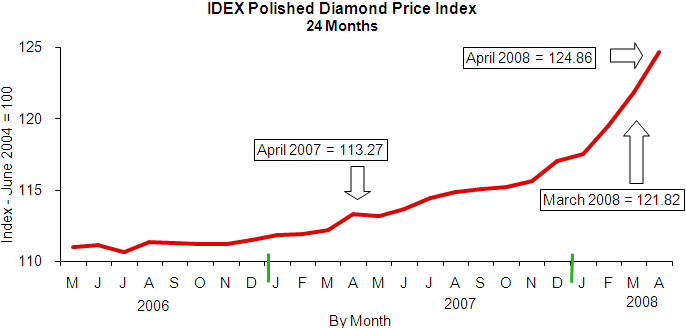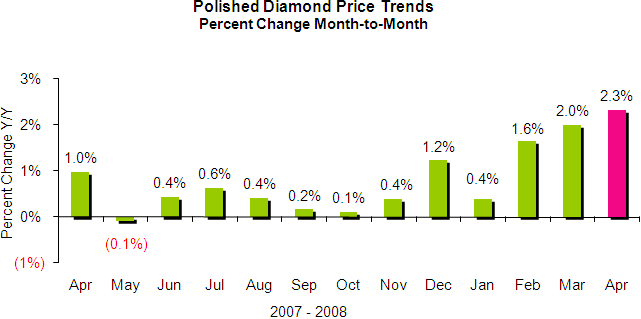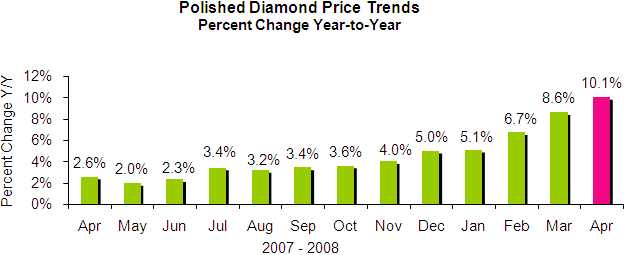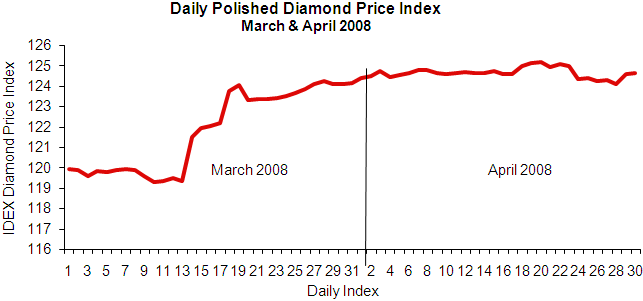IDEX Online Research: Polished Diamond Price Inflation Shows Dramatic Rise in April
May 04, 08
Energy prices continue to spike; food costs are higher; clothing prices are up. Global prices of virtually all goods are on the rise, and inflation is the main topic in news headlines around the world. So it should be no surprise that polished diamond prices are also caught up in this inflation frenzy.
Global polished diamond prices posted a record level price increase of just over 10 percent in April 2008, when compared to the same month a year ago, based on the IDEX Online Polished Diamond Price Index. On a month-to-month basis, polished diamond prices also rose by a record level of 2.3 percent, according to the IDEX Online Index.
While the economy of the U.S., which represents just less than 30 percent of the global economy and about 50 percent of global diamond consumption, appears to be mired in a recessionary mode, there is no shortage of demand for high quality polished diamonds in other world markets. Diamond buyers in Asia, the Middle East, India and China have stepped in, and they are bidding up prices, especially among the larger stones – three carats and above.
We continue to cite five key drivers of higher prices for polished diamonds: 1) solid consumer demand from most markets, except the U.S. and Japan; 2) rising costs throughout the diamond pipeline; 3) a weakening U.S. dollar, the current international currency for the diamond market; 4) a global rise in the price of virtually all commodities which has spilled over into the diamond market; and 5) stock market volatility which has caused some traders to move their wealth into diamonds, precious metals, and other assets that may hold their value, until the financial markets stabilize and recover.
The big question we have been asking all along – will these diamond price increases hold at retail, or will merchants negotiate them down? – appears to have been answered. Because of strong demand for polished diamonds in other global markets, diamond suppliers have been able to maintain their price increases. If a U.S. customer bulks at paying higher prices for diamonds, the diamond supplier simply moves on to another market where demand is strong.
We continue to worry about such dramatic price inflation for polished diamonds. However, the Diamond Trading Company apparently feels otherwise. In a recent interview in Antwerp Facets magazine, DTC managing director Varda Shine tackled this question: Due to the prospect that diamond prices are expected to continue to rise over the long term, is there a risk that diamonds may become an item beyond the reach of ordinary consumers? Her answer: “We [the DTC] are encouraged to see demand growth for diamonds, and we believe that there is a diamond for everyone. Diamonds are a luxury product competing with other luxury products. They are rare and beautiful and should be demanding prices that reflect that.”
Our outlook: as long as the demand for diamonds and diamond jewelry remains strong, especially in emerging markets, prices are expected to rise. Further, since rough diamond prices have been rising faster than polished diamond prices, there is on-going pressure to pass along those price increases. So far this year, rough diamond prices are up about 8.5 percent based on results of DTC Sights; polished prices are up by just over 6 percent since the end of 2007, based on the IDEX Online Polished Diamond Price Index.

Source: IDEX Online Research
April 2008 versus March 2008: +2.3 percent 
Global polished diamond prices were up sharply –2.3 percent – on a month-to-month basis – April 2008 versus March 2008. April’s month-to-month surge was the largest gain on record since IDEX Online has been tracking polished diamond prices (June 2004), and it exceeded the 2.0 percent record monthly gain in March 2008. On an annualized basis, this is a dramatic 28 percent gain in polished diamond prices, a rate that seems both unreasonable and unsustainable. With sharp price increases since the beginning of the year, we believe that this could be setting a trend for the balance of 2008. The IDEX Online Polished Diamond Price Index, calculated on the average daily prices during April 2008, stood at 124.86 for the month, up 2.3 percent from 121.82 for the month of March. The IDEX Online Polished Diamond Price Index stood at 100.00 in July 2004.

Source: IDEX Online Research
April 2008 versus April 2007: +10.1 percent 
While we continue to worry about the sustainability of such large year-over-year price increases in polished diamonds, the market appears to be operating in a true capitalistic supply-versus-demand mode. If demand remains strong, prices will rise. Conversely, if demand weakens, prices could drop. The DTC has effectively relinquished price control to the market, and thus the broad market will ultimately determine prices. Those with a long term vision understand that prices will wax and wane more than in the past, since the DTC no longer uses a buffer stock to help reduce price volatility. In short, enjoy this ride as long as it lasts. The IDEX Online Polished Diamond Price Index stood at 124.86 in April 2008 versus 113.27 in April a year ago.
On a year-over-year basis, polished diamond prices have shown larger and larger gains each month over the past year or so. The graph below summarizes year-over-year monthly polished diamond prices for the global market since the beginning of 2007.
Comparisons are based on the daily average prices during the month versus the same month a year ago (e.g. April 2008 versus April 2007). The year-to-year comparison takes into account the seasonality of polished diamond demand and prices.

Source: IDEX Online Research
Day-to-Day Polished Diamond Prices Were Steady in April
While diamond prices showed a dramatic increase in April based on comparisons of the average prices for the month, the real spike in diamond prices occurred in March.
We normally show a one-month daily graph of diamond prices, but it is more instructive to see daily diamond prices on a two-month basis, in order to understand when polished diamond prices actually surged.
In March, there was a sharp spike mid-month, and those higher prices carried over into April. However, while prices were at record levels in April, they were relatively flat throughout the month. The market was apparently digesting the price spike which occurred in March; many suppliers were waiting to see if prices would hold firm. They were rewarded for their patience: prices were steady in April.

Source: IDEX Online Research
Diamond Demand Remains Strong for Large Sizes
Month after month, jewelers report that larger, better quality diamonds are in demand, and the prices of these spectacular gemstones reflects strong retail demand. However, it is interesting to note that three-carat stones showed the largest gains in April on a month-to-month comparison; four- and five-carat stones showed smaller gains. In markets such as the U.S. which are in a recessionary environment, this is to be expected: most consumers at all levels appear to be “shopping down.” Rather than purchase a five-carat stone as a second diamond for the same wife, some shoppers are opting for slightly smaller, though still flashy, three- and four-carat stones.

Source: IDEX Online Research
On a year-to-year comparison, polished diamond prices showed a greater bias: prices for large stones in the three-to-five carat range rose much more sharply while prices of stones two-carat and smaller posted only a small, but notable, gain. Did four-carat polished diamonds really rise by nearly 66 percent year-over-year? Ask any diamantaire who deals in large high quality stones: they will confirm that prices are spiking daily.
Following February and March, April is the third consecutive month when all key diamond sizes – one-half carat through five-carat stones – showed a price increase on a year-over-year basis. The price increase for smaller stones in the one-half carat size range was modest, but it was up.

Source: IDEX Online Research
Forecast: Polished Diamond Prices Higher, With No End in Sight
Economists continue to forecast that global economic growth will decelerate modestly during 2008, particularly among two of the world’s larger economies – Japan and the U.S. In the U.S., economists are predicting a short recession, no more than two quarters in length. Consumers have been in a mental recession, and have cut back on their discretionary spending.
Already, there are signs that the job market cutbacks may have bottomed, and there are forecasters who say they see the housing bust hitting bottom this spring. Interest rates are at a four-year low and preliminary first quarter economic growth was slightly positive, rather than negative, as many economists had feared.
However, economic woes in the U.S. market will spill over into other markets. The U.S. market historically has about half of all the world’s diamonds and diamond jewelry by value. High growth economies – such as China and India – say they are reining in growth in an effort to avoid inflation. As a result, jewelry and diamond demand during 2008 is expected to moderate, though gains will likely be solid. While this forecast may seem unrealistic in light of the surging growth we have seen since the beginning of the year, our long term forecast algorithms continue to suggest that the pace of polished diamond price increases cannot continue unabated.
Because rough diamond prices are rising at a pace faster than polished diamond prices, there is much pressure on cutters and polishers to raise their prices, a trend that is likely to continue. This will keep polished diamond prices from falling, and should provide support, along with baseline consumer demand, to send prices higher, but at a more moderate rate, in our opinion.
The IDEX Online Diamond Price Index
The IDEX Online Diamond Price Index is a real-time index derived from actual asking prices in the global diamond industry. The IDEX Online Diamond Price Index objectively reflects price trends as they happen. The Diamond Index and Diamond Drivers were formulated following comprehensive research and analysis of the IDEX Online inventory database, aggregated since 2001. Research and development were conducted in cooperation with Dr. Avi Wohl, Senior Lecturer of Finance at the faculty of Management, Tel Aviv University, Israel.
Additional information is available from IDEX Online Research. The e-mail address is diamondprices[at]idexonline[dot]com.